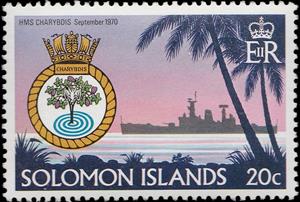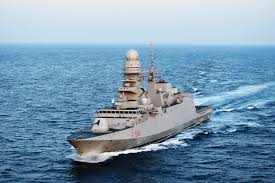Stamp: HMS Charybdis (Frigate) (Solomon Islands 1981)
HMS Charybdis (Frigate) (Solomon Islands 1981)
14 January (Solomon Islands ) within release Ships and Crests (2nd Series) goes into circulation Stamp HMS Charybdis (Frigate) face value 20 Solomon Islands cent
| Stamp HMS Charybdis (Frigate) in catalogues | |
|---|---|
| Michel: | Mi:SB 427 |
| Stanley Gibbons: | Sg:SB 431 |
Stamp is horizontal format.
Also in the issue Ships and Crests (2nd Series):
- Stamp - HMS Mounts Bay (Frigate) face value 8;
- Stamp - HMS Charybdis (Frigate) face value 20;
- Stamp - HMS Hydra (Survey Ship) face value 45;
- Stamp - Royal Yacht Britannia face value 1;
Stamp HMS Charybdis (Frigate) it reflects the thematic directions:
A ship is a large watercraft that travels the world's oceans and other sufficiently deep waterways, carrying passengers or goods, or in support of specialized missions, such as defense, research and fishing. Historically, a "ship" was a sailing vessel with at least three square-rigged masts and a full bowsprit. Ships are generally distinguished from boats, based on size, shape and load capacity.
A map is a symbolic depiction emphasizing relationships between elements of some space, such as objects, regions, or themes. Many maps are static, fixed to paper or some other durable medium, while others are dynamic or interactive. Although most commonly used to depict geography, maps may represent any space, real or imagined, without regard to context or scale, such as in brain mapping, DNA mapping, or computer network topology mapping. The space being mapped may be two dimensional, such as the surface of the earth, three dimensional, such as the interior of the earth, or even more abstract spaces of any dimension, such as arise in modeling phenomena having many independent variables. Although the earliest maps known are of the heavens, geographic maps of territory have a very long tradition and exist from ancient times. The word "map" comes from the medieval Latin Mappa mundi, wherein mappa meant napkin or cloth and mundi the world. Thus, "map" became the shortened term referring to a two-dimensional representation of the surface of the world.
A coat of arms is an heraldic visual design on an escutcheon (i.e. shield), surcoat, or tabard. The coat of arms on an escutcheon forms the central element of the full heraldic achievement which in its whole consists of shield, supporters, crest, and motto. A coat of arms is traditionally unique to an individual person, family (except in the United Kingdom), state, organisation or corporation.
A warship or combatant ship is a ship that is used for naval warfare. Usually they belong to the navy branch of the armed forces of a nation, though they have also been operated by individuals, cooperatives and corporations. As well as being armed, warships are designed to withstand damage and are typically faster and more maneuverable than merchant ships. Unlike a merchant ship, which carries cargo, a warship typically carries only weapons, ammunition and supplies for its crew.




